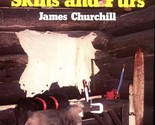FREE Shipping Orders Over $50.00
The most comprehensive, easy-to-follow information available on
do-it-yourself tanning techniques and tools ...
The Complete Book of
TANNING
Skins and Furs
James Churchill
Here is everything you need to know to make soft leather and dressed furs
from the skins of small and large furbearers, domestic animals, reptiles, and
birds. Organization is by specific animals, including:
rabbit
raccoon
calf
squirrel
fox
goat
woodchuck
cow
coyote
deer
wolf
bear
horse
moose
otter
elk
badger
bull
weasel
fisher
alligator
mink
wildcat
birds
muskrat
sheep
fish
skunk
beaver
snakes
In addition to covering all types of skins,
beginning with those of small animals and graduating to larger, more difficult
projects. THE COMPLETE BOOK OF TANNING also details the tools and
equipment necessary for each. Information on making your own tools and
tanning solutions is also provided.
Whether you're a newcomer to tanning or and an
experienced hand, this is an invaluable guide to every facet of the age-old art.
With this how-to reference handy, you can learn to make a number of leather and
fur products that are useful and decorative.
Tanning is a functional art dating to Indian times.
In THE COMPLETE BOOK OF TANNING SKINS AND FURS, author James Churchill
recaptures the skill of those days with the most comprehensive set of how-to's
available for making soft leather and dressed furs today.
Beginning with a small animal such as a rabbit or
squirrel, the step-by-step instructions show and tell you how to:
* Peel off the skin
* Flesh it to remove every bit of meat and fat
* Hang the green hide for drying
* Mix the correct tanning solution for soaking
* Apply a coating of oil
* "Work" the flesh side until soft
* Clean the fur with sawdust or cornmeal
* Sand the flesh side and rub with oil.
Tips and sequential illustrations enhance each
project and lay the groundwork for tanning other small furbearers, large
furbearers, reptiles, birds, and thin- and thick-skinned domestic animals.
Churchill's easy-reference format includes a range of specific animals from
alligator to wildcat, including deer, moose bear, elk, raccoon, fox, beaver, and
even mule, bull, fish and snake.
The tools and equipment necessary for tanning are
also listed and explained. Churchill introduces skinning knives, fleshing
blades, fleshing beams, various tanning solutions, and other aids along with the
techniques in which they're used. Among the procedures discussed are:
selecting skins for special uses, softening the skin, skinning deer and making
buckskin, tanning heavy skins, deciding if a hide is "prime", storing hides to
avoid spoilage, cleaning fur, and making rawhide.
In addition, THE COMPLETE BOOK OF TANNING AND FURS
goes one step further in providing instructions for a number of practical uses.
Bear skins, which can be made into beautiful rugs or wall hangings that last a
lifetime and are profitable on the resale market as well, are treated into
unique wall decorations is also included, as are how-to's of making gloves,
boots, moccasins, jackets, and more.
Interesting background information adds to this
comprehensive portrait of tanning. Facts on animal skins--what they are
made of and why they can be preserved-- precedes specific instructional
sections, and a chapter on pioneer tanning methods thoroughly examines the roots
of this art in Indian life.
In these pages, Churchill gives you the means to
make the most of each "catch", using tanning skills that can equal those of
professionals. Tanning also makes a satisfying craft for beginners or
accomplished tanners who would like to try working with different types of
animal skins or creating new products. This is a complete guide of simple
instructions you can refer to again and again in preserving animal skins for
years of future use and enjoyment.
